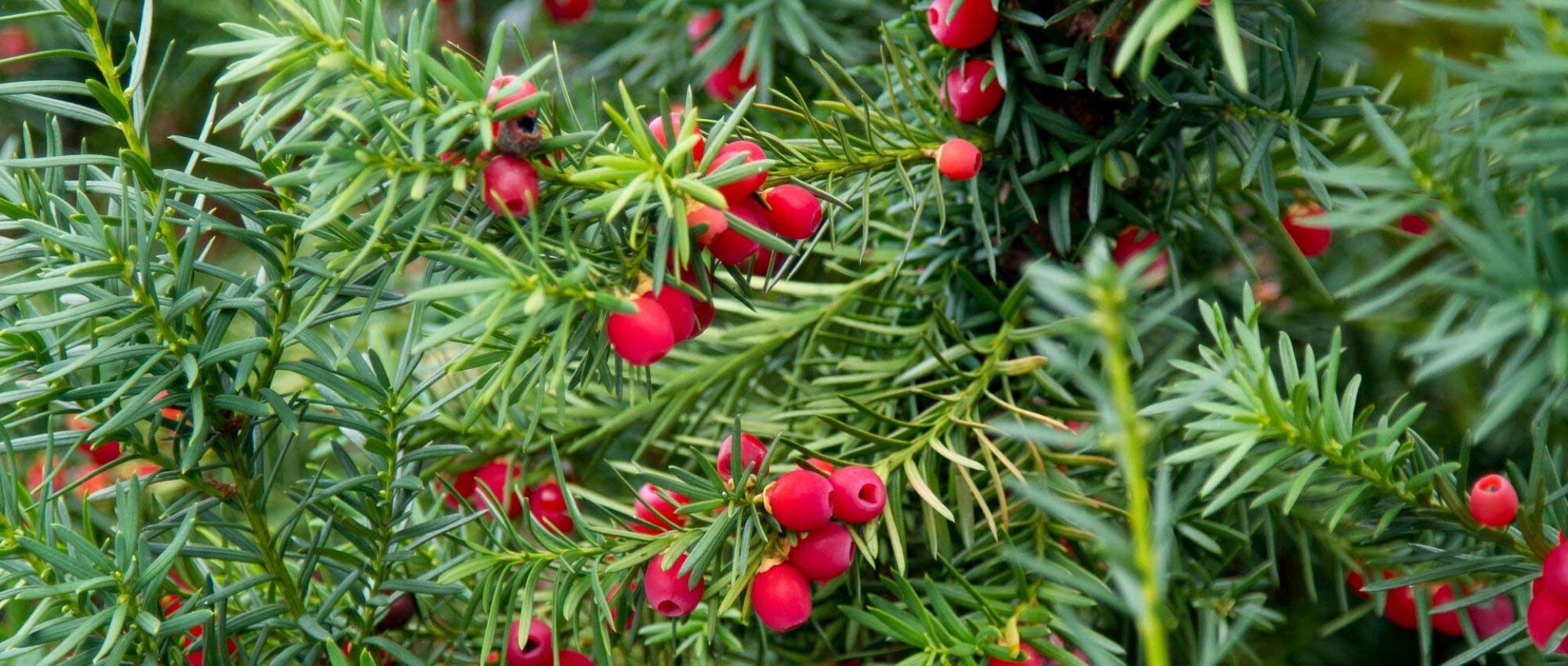
If, Taxus baccata: planting and care
Contents
The Yew in a nutshell
- Yew is the ideal conifer for creating topiary and structured hedges. It is perfect in a French garden.
- Its dense, evergreen foliage is dark green.
- It grows slowly but has a long lifespan.
- It is a sturdy, robust plant that is very easy to grow.
- Female plants bear very decorative red arils.
A word from our Expert
Yew is a superb conifer with dark green, dense, evergreen foliage, and a generally upright, conical shape. It is a robust plant that can live for a very long time! The most well-known is the Taxus baccata, the common Yew, but there are many varieties that differ in shape and colour. Yew is also a tree of great symbolic value, representing death and immortality; for this reason, it has often been planted in cemeteries or near churches.
Depending on the variety, Yew can take on very diverse shapes: fastigiate and very tall, spreading groundcover, medium-sized dense bush… Moreover, the way it is pruned also allows for a variety of forms: columnar, pyramidal, cubical, hedges, cloud shapes… It offers numerous possibilities!
Easy to grow, Yew thrives in both sun and dense shade, in acidic soils as well as calcareous substrates; strong winds do not faze it, nor does air pollution… In short, it is comfortable just about anywhere! In addition to these advantages, Yew tolerates pruning exceptionally well. It is ideal for creating topiary in a French garden or for forming dense, evergreen hedges. Its only drawback may be its slow growth… but this means less frequent pruning is required!
Description and Botany
Botanical data
- Latin name Taxus baccata
- Family Taxaceae
- Common name Yew
- Flowering in early spring (April), but not very decorative.
- Height up to 20 m
- Exposure sun, shade or partial shade
- Soil type cool, draining, acidic or calcareous
- Hardiness between -15 and -20 °C
Yews are evergreen conifers with dark green foliage, either tree-like or shrub-like. They are often used in topiary art, as they respond well to pruning. The most well-known and widespread is the Taxus baccata, commonly known as the Common Yew. It is primarily native to Europe and North Africa, and can often be found in the wild in forests across France. There are nine botanical species of Yew, and over 400 horticultural varieties, often derived from Taxus baccata or Taxus cuspidata. The Yew is a unique conifer: unlike most, it does not produce cones or resin!
Taxus baccata has given its name to the botanical family Taxaceae, which includes 31 species across five genera. The species name baccata means “bearing berries,” referring to the red arils (though they are not berries in the botanical sense!). The name Taxus has led to the Latin word taxicum: “poison,” as all parts of the plant, except for the arils, are toxic.
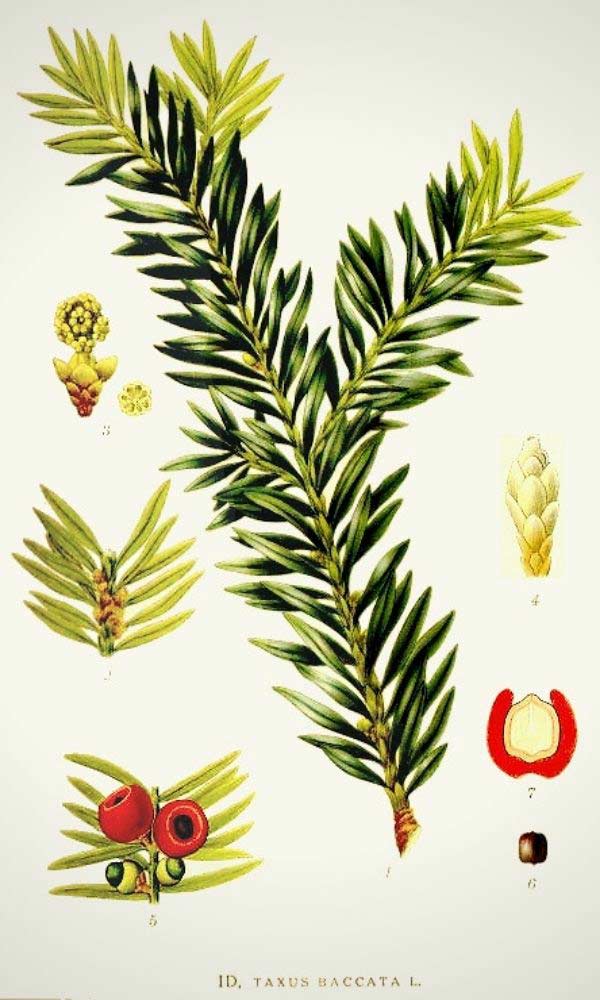
Taxus baccata: Botanical illustration
While it is true that it grows very slowly, the Yew has an exceptional longevity, as evidenced by the Fortingall Yew in Scotland, which is estimated to be over 2,000 years old!
The Yew is also a highly symbolic tree, often associated with ancient druidic or pagan beliefs. It represents both death and immortality, the latter illustrated by its evergreen nature and great longevity. Yews have often been planted in cemeteries and near churches.
It is not uncommon for the trunks of old Yews to become hollow over time. In fact, the two Yews in La Haye-de-Routot, in Eure, house a chapel and an oratory. Near Dinan, the Yew in Yvignac-la-Tour hosted a concert in 2018 within its trunk, featuring 28 singers!

Over time, the trunks of Yews become more or less twisted and can hollow out. An avenue of Yews towards Whorlton, an old Yew with a hollow trunk, and a Yew with roots running over a rock (photos: Mick Garratt – Jonathan Kington – Marco Schmidt)
Yews generally have a conical, pyramidal habit, and can reach up to 20 metres in height. They naturally have a beautiful silhouette, with numerous branches made up of a multitude of small leaves, giving a dense and bushy effect. They also have the advantage of being branched from the base. Their bark is reddish-brown and flakes off in small scales.
The varieties offer a great diversity of forms: some are very tall and fastigiate, while others are creeping. For instance, the Taxus baccata ‘Repandens’ forms a groundcover that does not exceed 60 cm in height!
The Yew has superb, dense dark green foliage, consisting of linear, narrow, and flattened leaves that measure two to three centimetres long. They are flexible and do not prick! They are inserted in a spiral on the stem but give the impression of being arranged in two ranks on either side. These leaves persist for at least six or seven years on the tree and renew gradually. They are not fragrant and do not contain resin!
The leaves of the Yew generally have a beautiful dark green colour on top and are lighter underneath, but there are also varieties with yellow leaves, such as Taxus baccata ‘Semperaurea’!

The foliage of Taxus baccata, and the varieties ‘Fastigiata Aurea’ and ‘Ivory Tower’ (photo Denolf)
Yews flower in early spring, around April, but their flowers are quite insignificant and discreet. They are dioecious: there are male and female plants (a rare character for a conifer!). The males bear yellow flowers arranged in clusters beneath the branches, releasing pollen. The female plants bear green flowers surrounded by imbricate scales, located on the branches. These are the ones that will bear the red arils and seeds. Pollination (the transfer of pollen to female flowers) occurs via the wind.
The Yew has a densely ramified root system, with a large number of rootlets. Generally, its roots are deep and extensive.
The Yew is one of the few conifers that does not produce woody cones (dry fruits containing seeds between their scales). Instead of these cones, the female plants produce red, oblong, fleshy arils, which are very decorative. They typically mature in September-October. Although they resemble berries, they are not a true fruit. Each aril surrounds a single, highly toxic seed. The arils are appreciated by birds (especially thrushes!), which do not digest the seeds and are therefore unaffected by their toxicity. They can thus disperse them intact, allowing the Yew to reseed itself in nature.
The Yew is the ideal plant for creating sculptures and topiary: it grows slowly (thus requiring less frequent pruning), it is branched from the base, has dense evergreen foliage, and can easily regrow leaves and branches on old wood. It can therefore withstand even severe pruning without issue!
The Yew is known for its quality wood, which is very hard yet relatively flexible. It has a beautiful reddish-orange colour at the core and light brown on the periphery. It has been used since prehistoric times (for weapons, bows, arrows, various objects…), and today remains highly valued by cabinetmakers, luthiers, and sculptors.

The flowers of the Yew, its fruits, and its seeds (photo Didier Descouens – Museum of Toulouse)
Read also
Major diseases and pests of conifersThe main varieties of Yews
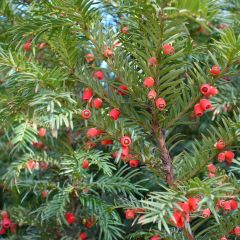
Taxus baccata - Yew
- Height at maturity 10 m
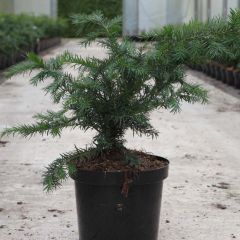
Taxus baccata Repandens - Yew
- Height at maturity 55 cm
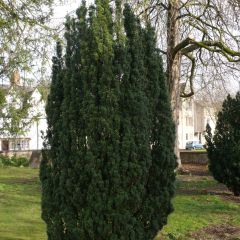
Taxus baccata Fastigiata Robusta - Yew
- Height at maturity 3 m
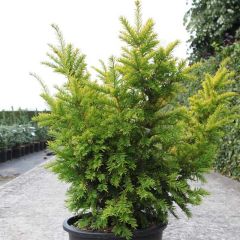
Taxus baccata Semperaurea - Yew
- Height at maturity 2,75 m
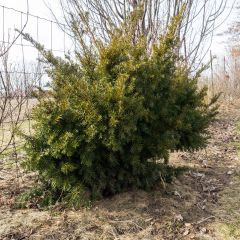
Taxus media Densiformis - Yew
- Height at maturity 1 m
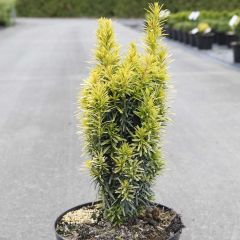
Taxus baccata Ivory Tower - Yew
- Height at maturity 3 m
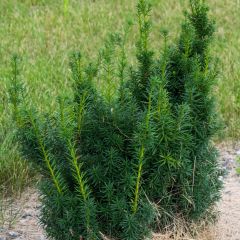
Taxus media Hicksii - Yew
- Height at maturity 2,50 m
Discover other Taxus - Yew
View all →Available in 4 sizes
Available in 1 sizes
Available in 1 sizes
Available in 1 sizes
Available in 2 sizes
Available in 1 sizes
Available in 1 sizes
Available in 1 sizes
Available in 2 sizes
Planting Yew
Where to Plant?
The Yew is not a demanding tree; it thrives equally well in both sun and dense shade! Thus, it can be planted almost anywhere! However, it is best to avoid scorching sun if you live in the south of France, as well as waterlogged soils or, conversely, very dry ones. Overall, it grows well in any ordinary, cool, and well-draining soil. Not particularly sensitive to pH, it can thrive in acidic, calcareous, or neutral soils. It also tolerates wind and salt spray, as well as air pollution without any issues!
The Yew is an ideal element for structuring the garden, whether in a columnar form, very tall, or shaped into topiary. You can also plant it as a hedge, for example, along a path or to mark a boundary in the garden.
The variety you choose will also determine the location. Columnar and upright varieties are ideal when isolated, for instance, in the middle of a lawn, while creeping varieties are perfect for covering a slope… Those with golden foliage beautifully illuminate shady areas, while those with dark green leaves stand out better when in the sun.
You can incorporate it into a graphic garden by pruning it into a well-structured shape: pyramid, cube, hedge… And if you shape it into a cloud, it will fit very well into a Japanese garden.
The Yew also adapts well to small gardens. In this case, it is preferable to choose modest-sized varieties, such as Taxus media ‘Densiformis’.
As the Yew grows slowly, it takes time before it forms a beautiful hedge or takes on an imposing silhouette. Therefore, to achieve a lovely effect quickly, opt for larger specimens rather than small young plants in pots when purchasing. Another option is to consider Taxus x media, which grows faster than other varieties!
To allow it to truly flourish, it is better to plant it in the ground rather than in a pot. However, some dwarf forms can adapt to being planted in a large container.
When to Plant?
You can plant it in spring (April-May) or in autumn (September-October). Avoid the height of summer, to prevent it from suffering from drought, as well as winter: just after planting, the cold could weaken it.
How to Plant?
For isolated planting:
- First, start by placing the root ball in a basin filled with water. This helps to moisten it and improve establishment.
- Dig a large planting hole. Ideally, it should be about three times the size of the root ball.
- Add well-decomposed compost, mixing it with the garden soil. You can also add a bit of slow-release fertiliser.
- Remove the yew from its pot, and place it in the planting hole. The final soil level should be just at the collar of the plant (the transition zone between the root and aerial parts).
- Fill the hole by replacing the soil all around, and lightly firm it down.
- You can create a watering basin, which will retain water at the base of the plant.
- Water generously.
If you are planting a hedge:
- Dig a trench, proportionally two to three times wider and deeper than the volume of the root balls you will be planting.
- Add some well-decomposed compost, mixing it with the planting soil.
- Place your plants in the trench, maintaining about 80 centimetres of distance between them.
- Fill with soil and then lightly firm it down.
- Water abundantly.
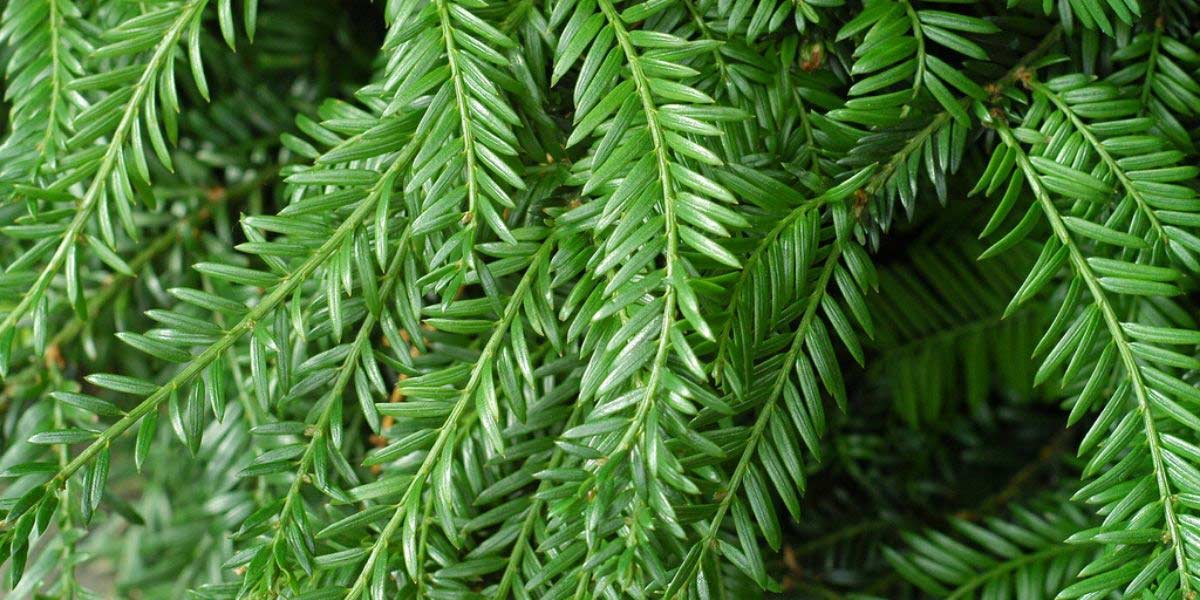
Common Yew, Taxus baccata
Read also
Phytophtora : identify, prevent, controlEntretien
Yew is quite easy to maintain and doesn’t require much attention. Its slow growth is actually an advantage: it can be pruned less frequently.
In the first year, you can do some watering. After that, it won’t need watering unless there is significant drought.
Every autumn, you can add some well-decomposed compost around the base and lightly incorporate it into the soil with a gentle raking. If you are growing it in a container, use slow-release fertiliser instead. We also recommend placing a thick layer of organic mulch at its base to keep the soil cool.
Yew is rarely attacked by pests, as its tissues contain toxic substances. However, it can sometimes fall victim to the caterpillar of the tortrix moth, which feeds on the leaves of the yew. It may also be affected by vine weevils or scale insects. Generally, the damage caused by these insects is quite limited and does not threaten the life of the tree, as yew is particularly sturdy and resilient.
In moist soil, yew can be affected by Phytophthora, a fungus that causes the root system to rot. The foliage discolours and dries out, and the entire tree begins to decline. To prevent this disease, it is important to grow yew in well-draining substrate where water does not stagnate. For more information, please consult our advice sheet: “Phytophthora: identify, prevent, control”
How to Prune?
Yew can easily do without pruning, especially for fastigiate forms, which naturally have a beautiful structured silhouette. However, if you wish to create topiary or architectural shapes, you can certainly prune it.
→ Follow our tips in this article: “Pruning Yew: When and How“
Multiplication: propagation by cuttings
The best technique for propagating Yew is by cuttings. Sowing is not really interesting, as the seeds can take more than two years to germinate… It therefore takes years before obtaining a plant of sufficient size to be planted in the garden.
Propagation by Cuttings
Yew is quite easy to propagate by cuttings. The best time is late summer or early autumn (September-October). This way, you will obtain new plants that can be used, for example, to create a hedge.
- Take a section of 15 to 20 cm in length from a current year’s branch. Ideally, take a cutting with a heel, keeping a small section of the branch that bore it at the base. The presence of this “heel” will encourage root development.
- Remove the leaves from the lower part of the branch (about 10 cm).
- Prepare a pot with substrate, ideally potting soil mixed with sand.
- Water it to ensure it is well moist.
- Optionally, dip the base of the cutting in plant hormone.
- Then plant it in the pot, and firm the soil around it well.
- Place your cutting in a bright location, out of direct sunlight, and ensure the substrate remains relatively cool until it takes root. You can also cover the pot with a plastic bag or a plastic bottle to maintain a humid atmosphere (closed propagation).
Remember that Yew grows slowly. It will take some time for the plants to reach a sufficient size to be planted in the garden.
Associating Taxus in the garden
The Taxus will naturally find its place in a French garden, where it can be sculpted to form topiary or straight hedges. You can pair it with box or other shrubs that can be trimmed into topiary: crenate holly, Osmanthus x burkwoodii, Lonicera nitida… Also consider Hornbeam, which has beautiful dentate foliage. Create flower beds with, for example, tulips, marigolds, cosmos, dahlias, ornamental garlic, Salvia nemorosa…
It may seem tricky to plant directly at the foot of a conifer like the Yew, as its roots tend to dry out the soil, its falling needles slightly acidify the substrate, and its foliage creates quite dense shade. However, you can easily pair it with small, low-maintenance groundcover plants, such as periwinkle or variegated ivy, which will add brightness. It is also possible to plant cyclamen, heathers, heucheras…
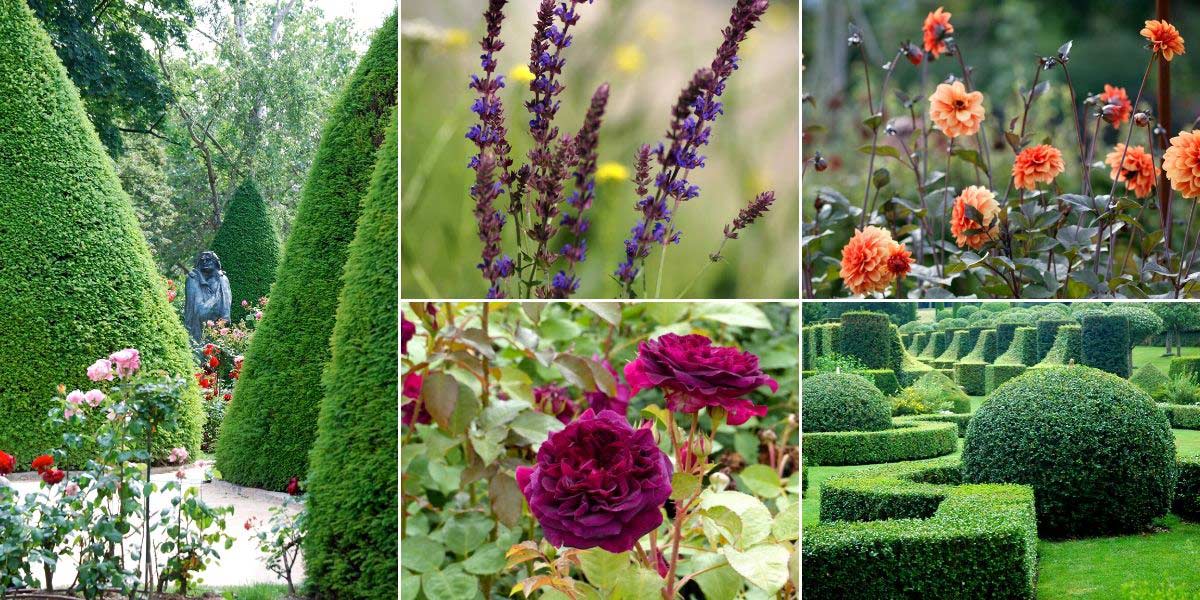
You can integrate the Yew into a French garden, alongside other shrubs trimmed into topiary and colourful perennial flower beds! Trimmed Yews (photo Albany Tim), Salvia nemorosa (photo Rolf Engstrand), Dahlia ‘David Howard’ (photo Leontine Trijber – iBulb), Rose ‘Munstead Wood’, Topiary Box at the Eyrignac garden (photo Patrick Giraud)
The Taxus also pairs well with heather soil shrubs, such as rhododendron, Skimmia, Daphne, Pieris japonica, Sarcococca… Enjoy the stunning foliage of heavenly bamboo, Nandina domestica. The decorative bark of Cornus will also complement the Taxus beautifully. Don’t forget about ferns, whose airy and light fronds will create a contrast against the dense foliage of the Yew.
Finally, you can certainly trim it into a cloud shape and integrate it into a Japanese garden. For this, we particularly recommend Taxus cuspidata. You can pair it with hostas, Japanese maples, Hakonechloa macra, Japanese anemone, as well as ferns like Coniogramme emeiensis.
If you are growing columnar varieties that are very tall, don’t hesitate to plant them in isolation, for example in a lawn area, to highlight them and showcase their stunning silhouette. They will draw the eye and serve as a structural element in your garden.
Useful resources
- Discover our range of Taxus
- An article by Ingrid on our blog: “5 reasons to plant conifers in the garden”
- Our advice sheet: “Diseases and pests of conifers”
- An article by Michael on our blog: “Are conifers kitsch bushes?”
- Discover in Olivier’s video a little cousin of the Yew, the Cephalotaxus harringtonia
- Check out our tutorial: How to propagate conifers?
- Learn more about toxic bushes and toxic berry plants in our advice sheet
Frequently asked questions
-
Why is the foliage of my Yew turning yellow?
It is likely suffering from excess moisture or heavy, compact soil that prevents the roots from breathing. We recommend limiting watering. If your Yew is still young, you might consider transplanting it to a drier location or growing it in a container. You can also scratch the surface of the soil to aerate it. If the foliage turns brown and dries out, it is probable that your Yew is affected by Phytophthora.
- Subscribe!
- Contents
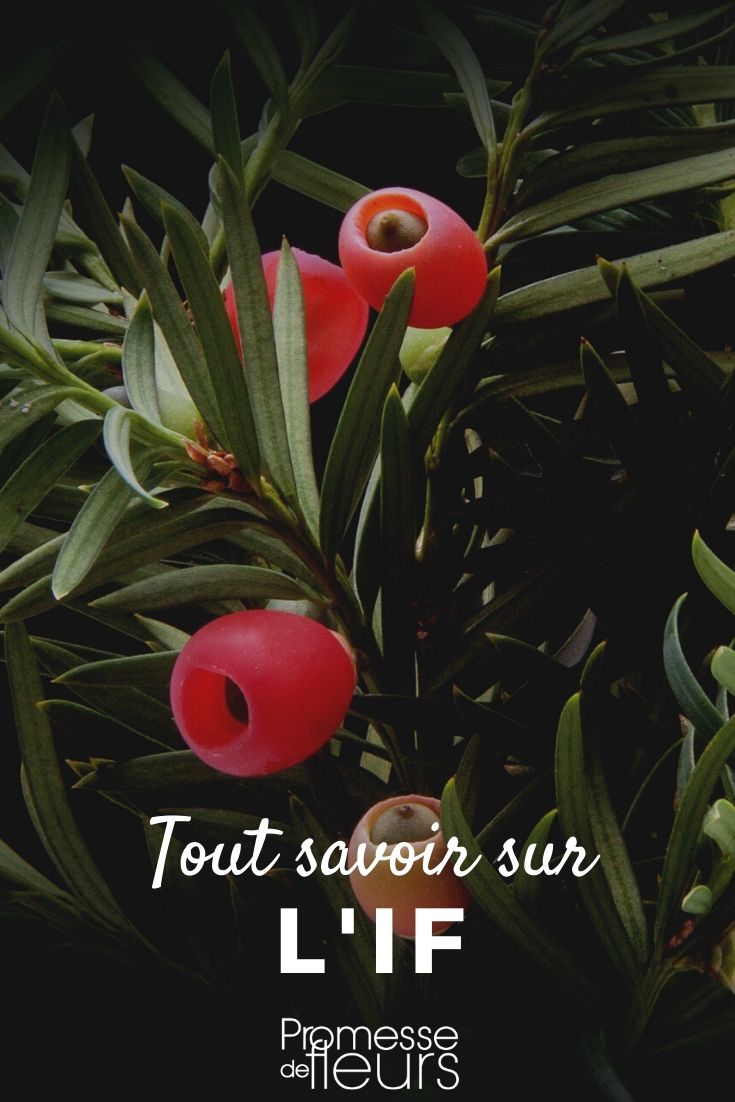
































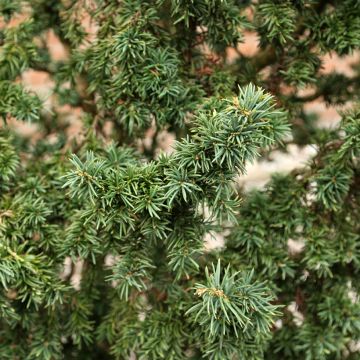
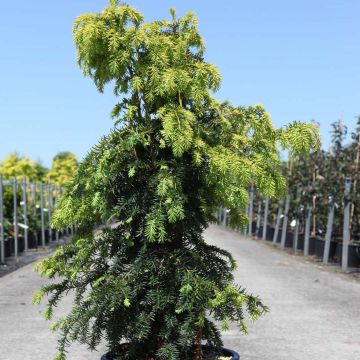
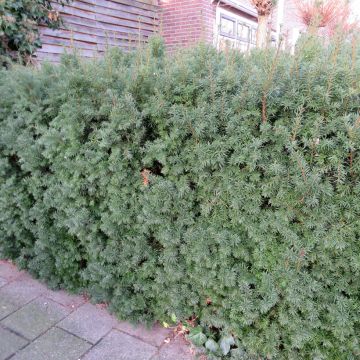
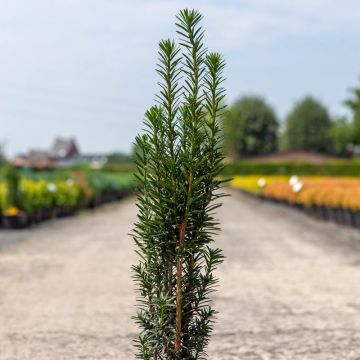
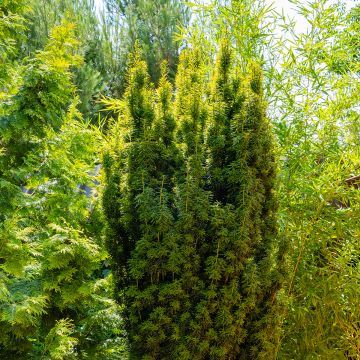
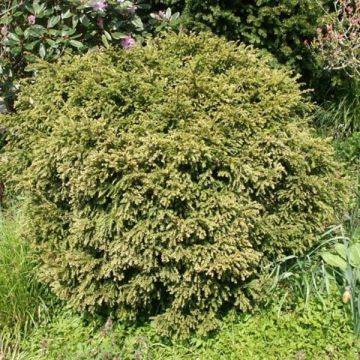
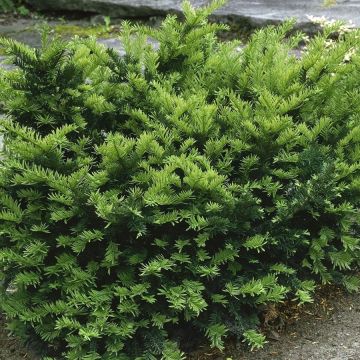

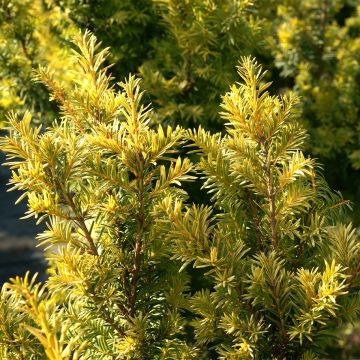
Comments